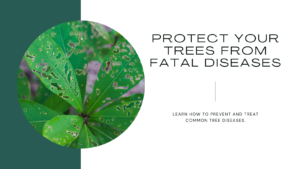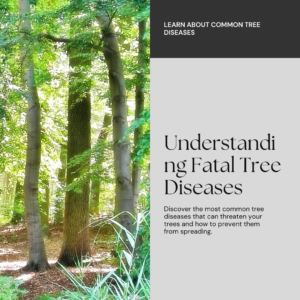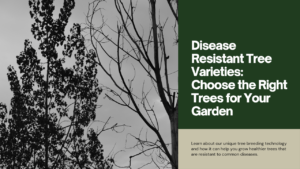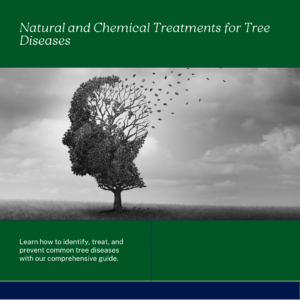
When it comes to the health of your trees, prevention is always better than cure. Trees can be susceptible to various diseases that can pose a threat to their well-being and vitality. However, with the right knowledge and care, you can protect your trees from these fatal diseases and ensure their longevity. In this section, we will provide you with valuable tips and expert advice on preventing tree diseases, recognizing their symptoms, and implementing effective care and treatment methods.
Key Takeaways:
- Being proactive in preventing tree diseases is crucial for the health and longevity of your trees.
- Recognizing the symptoms of tree diseases can help you take prompt action and prevent further damage.
- Proper tree care practices, such as pruning and correct watering, can significantly reduce the risk of diseases.
- Choosing disease-resistant tree varieties is a wise decision to prevent infections in the first place.
- Early detection and prompt treatment are essential to limit the spread of diseases and save your trees.
Understanding Tree Diseases: Common Fatal Diseases that Threaten Trees

When it comes to the health and well-being of your trees, understanding tree diseases is crucial. By familiarizing yourself with common fatal diseases that threaten trees, you can take proactive measures to protect your beloved arboreal companions.
Tree diseases can manifest in various forms, affecting different parts such as leaves, branches, and roots. These diseases can be caused by fungi, bacteria, viruses, or environmental factors. Identifying symptoms early on is essential to prevent further damage and ensure the longevity of your trees.
Here are some of the common fatal diseases that pose a threat to trees:
- Anthracnose: This fungal disease affects deciduous trees, causing irregularly shaped lesions on leaves and stems. Anthracnose can lead to defoliation and weaken the overall health of the tree.
- Phytophthora Root Rot: This soil-borne disease affects the root system, causing decay and rot. It can lead to stunted growth, wilting, and eventual death of the tree.
- Emerald Ash Borer: This invasive beetle species attacks ash trees, laying eggs in the bark and disrupting the tree’s vascular system. Infested trees often show signs of dieback, D-shaped exit holes, and canopy thinning.
- Dutch Elm Disease: Caused by a fungal pathogen, Dutch Elm Disease affects elm trees, leading to wilting, yellowing leaves, and tree death. It is spread through elm bark beetles.
- Sudden Oak Death: This disease affects various oak tree species and is caused by a water mold called Phytophthora ramorum. It causes leaf browning and twig dieback, eventually leading to tree mortality.
Understanding these and other common tree diseases empowers you to be vigilant in detecting early symptoms and seeking appropriate treatment. By taking timely action, you can mitigate the impact of these diseases and preserve the health and beauty of your trees.
Next, we will explore how to identify tree diseases and their symptoms in greater detail. This knowledge will hone your ability to recognize potential issues and implement effective care and treatment strategies.
Identifying Tree Diseases and Their Symptoms
In order to protect your trees from the devastating effects of diseases, it’s crucial to be able to identify the early symptoms. By recognizing these symptoms promptly, you can take immediate action and prevent further damage to your precious trees. Here, we will guide you through the process of identifying common tree diseases and understanding their associated symptoms.
1. Visual Symptoms:
Taking a careful look at your trees can give you important clues about their health. Keep an eye out for the following visual symptoms:
- Yellowing or browning leaves
- Wilting or drooping branches
- Leaf spots or discoloration
- Unusual growth patterns or stunted growth
- Bark abnormalities, such as cracks or peeling
2. Fungal Infections:
Fungal infections are a common cause of tree diseases. Look for the following signs of fungal infection:
- Mushrooms or fungal growth on the trunk or branches
- Cankers or oozing sap
- Powdery or fuzzy growth on leaves and branches
- Galls or abnormal growths on the bark or twigs
3. Pest Infestations:
Pests can weaken trees and make them more susceptible to diseases. Watch out for these indications of pest infestations:
- Bite marks on leaves or bark
- Webs, nests, or cocoons
- Presence of insects or larvae
- Increased bird activity near the tree
4. Declining Health:
If your tree is exhibiting overall decline in health, it could be a sign of an underlying disease. Look out for these general symptoms of declining tree health:
- Thinning canopy
- Branch dieback
- Premature leaf drop
- Slow or no growth
Remember, early intervention is key to stopping the progression of tree diseases. If you notice any of these symptoms in your trees, it’s important to consult with a certified arborist or tree care professional who can accurately diagnose the problem and recommend the appropriate course of action.
In the next section, we will examine the impact that fatal diseases can have on trees and the importance of proactive tree care to prevent such diseases from taking hold.
Stay tuned for the next section where we’ll explore the impact of fatal diseases on trees and the crucial steps you can take to keep your trees healthy and disease-free.
Understanding the Impact of Fatal Diseases on Trees
When it comes to the health of your trees, understanding the impact of fatal diseases is essential. These diseases can have devastating consequences, leading to irreversible damage and even the death of your beloved trees. By comprehending the severity of the situation, you will realize the urgency of proactive tree care and disease prevention.
Fatal diseases can manifest in various ways, affecting different parts of the tree, including the roots, trunk, branches, and leaves. They can weaken the tree’s immune system, making it vulnerable to other infestations and environmental stresses. The overall vitality and longevity of the tree are compromised, resulting in a significant negative impact on its appearance and structural integrity.
“Fatal diseases not only harm the individual tree but also have broader ecological consequences,”
says Dr. Emily Green, a renowned tree expert.
One of the key consequences of tree diseases is their potential to disrupt the ecological balance of an area. Trees play a critical role in maintaining the health of our environment by providing oxygen, filtering pollutants, and supporting wildlife habitats. When trees succumb to fatal diseases, it can create a ripple effect, affecting the entire ecosystem they are a part of.
- Loss of Shade and Aesthetic Value: Diseased trees often experience leaf loss or abnormal growth patterns, diminishing their ability to provide shade and contribute to the overall beauty of your landscape.
- Increased Safety Risks: Weakened trees are more susceptible to branch or trunk failure, posing potential hazards to people, structures, and other nearby trees. Timely identification and management of diseases can mitigate these risks.
- Decline in Property Value: Healthy, well-maintained trees enhance property aesthetics and value. Conversely, trees affected by fatal diseases can decrease the overall value and appeal of your property.
- Interference with Urban Infrastructure: Diseased trees with weakened root systems can compromise the stability of sidewalks, roads, and underground utilities, necessitating expensive repairs.
Recognizing the wide-ranging impact of fatal diseases on trees, it becomes evident that proactive measures are crucial. By prioritizing regular tree care, early detection of symptoms, and the implementation of effective disease prevention strategies, you can safeguard the health and longevity of your trees.
Proper Tree Care Practices to Prevent Diseases
Proper tree care practices are essential for maintaining the health and vitality of your trees. By implementing the following techniques, you can significantly reduce the risk of diseases and ensure the long-term survival of your beloved trees.
1. Pruning Techniques
Regular pruning plays a crucial role in preventing the spread of diseases. It helps remove dead or diseased branches, improving air circulation and reducing the risk of infection. Make sure to use clean and sharp pruning tools to minimize damage and prevent further stress to the tree.
2. Correct Watering
Proper watering is vital for the overall health of your trees. Overwatering can lead to root rot and promote the growth of fungal diseases, while underwatering can weaken trees and make them more susceptible to infections. Ensure that you water your trees deeply and infrequently, allowing the soil to dry between watering sessions.
3. Fertilization Methods
Applying the right fertilizer at the appropriate time can strengthen the immune system of your trees, making them more resilient to diseases. Consult with an arborist or horticulturist to determine the specific fertilizer requirements for your tree species and soil conditions.
4. Proper Mulching
Mulching provides various benefits, including conserving moisture, regulating soil temperature, and suppressing the growth of weeds. However, it’s crucial to implement proper mulching techniques to prevent the build-up of excess moisture, which can lead to fungal infections. Avoid piling mulch against the base of the tree and ensure that it extends no more than 2-3 inches from the trunk.
5. Sanitation Practices
Regularly inspect your trees for signs of diseases, such as fungal growth, cankers, or unusual leaf discoloration. If you notice any diseased plant parts, promptly remove and dispose of them properly to prevent the spread of pathogens.
| Proper Tree Care Practices to Prevent Diseases | Description |
|---|---|
| Pruning Techniques | Regularly remove dead or diseased branches to improve air circulation and reduce the risk of infection. |
| Correct Watering | Water deeply and infrequently, allowing the soil to dry between watering sessions to prevent root rot and fungal diseases. |
| Fertilization Methods | Apply the right fertilizer at the appropriate time to strengthen the tree’s immune system. |
| Proper Mulching | Implement proper mulching techniques to prevent excess moisture and fungal infections. |
| Sanitation Practices | Regularly inspect trees for signs of diseases and promptly remove and dispose of diseased plant parts. |
By incorporating these proper tree care practices into your routine, you can create a healthy environment for your trees, minimizing the risk of diseases and maximizing their longevity.
Disease Resistant Tree Varieties

When it comes to protecting your trees from diseases, prevention is key. One effective way to ensure the health and longevity of your trees is by selecting disease-resistant tree varieties. These tree species have natural defenses that make them less susceptible to common diseases, reducing the need for extensive care and treatments.
Choosing disease-resistant tree varieties offers numerous benefits. Not only do these trees have a better chance of surviving and thriving, but they also require less maintenance, saving you time and effort in the long run. Additionally, disease-resistant tree varieties contribute to the overall ecosystem by providing stability and beauty to your landscape.
Recommended Disease Resistant Tree Varieties
- Acer × freemanii (Autumn Blaze Maple) – This hybrid maple tree variety combines the best features of silver and red maples, offering resistance to various diseases such as leaf spot and canker.
- Cornus florida (Dogwood) – Dogwoods are known for their stunning flowers and resistance to powdery mildew, a common fungal disease that affects many tree species.
- Juniperus chinensis (Chinese Juniper) – Chinese junipers are highly resilient and resistant to many diseases, making them an excellent choice for landscapes with poor soil conditions.
- Pyrus calleryana (Bradford Pear) – Bradford pears are resistant to fire blight, a destructive bacterial disease that affects many fruit trees.
These are just a few examples of disease-resistant tree varieties. It’s important to consult with local experts, such as arborists or nursery professionals, to identify the best tree species that are resistant to diseases prevalent in your specific region.
By selecting disease-resistant tree varieties, you can enjoy the beauty and benefits of healthy trees while minimizing the risk of diseases. Remember to provide proper care and maintenance to ensure the long-term health of your trees.
Recognizing Early Signs of Infection
Early detection is essential when it comes to treating tree diseases effectively. By recognizing the early signs of infection, you can take prompt action and prevent further damage to your trees. In this section, we will guide you on how to identify these early signs, equipping you with the knowledge and tools to protect the health of your beloved trees.
When it comes to detecting infections in trees, it is crucial to pay attention to any changes in their appearance or behavior. Here are some early signs to look out for:
- Wilting or discoloration: If you notice that your tree’s leaves are wilting or changing color prematurely, it could be a sign of infection. Look for leaves that appear yellow, brown, or have unusual spots or patterns.
- Cankers or wounds: Pay close attention to the bark and branches of your trees. If you see any open sores, oozing sap, or wounds that don’t heal properly, it could indicate the presence of an infection.
- Abnormal growth: Keep an eye out for any unusual growth patterns, such as stunted or deformed branches, or excessive leaf drop. These could be signs that your tree is struggling with a disease.
- Pest infestations: Insects and pests are often attracted to weakened or infected trees. If you notice an increase in pest activity around your tree, it’s crucial to investigate further for possible infections.
Remember, early intervention is key when it comes to preventing tree diseases from spreading and causing irreparable damage. By recognizing these early signs of infection, you can take swift action and implement appropriate treatments to protect the health and longevity of your trees.
By regularly inspecting and monitoring your trees for any changes or symptoms, you can catch infections in their early stages and minimize the risk of severe damage. Investing time in learning about the early signs of infection is an essential part of being a responsible and proactive tree owner.
Stay vigilant and observe your trees closely. In the next section, we will explore the various natural and chemical treatments available for combating tree diseases and restoring the health of your precious green companions.
Natural and Chemical Treatments for Tree Diseases

When it comes to combating tree diseases, you have a range of treatment options to choose from. In this section, we will discuss both natural and chemical treatments and their effectiveness in controlling and preventing tree diseases.
Natural Treatments
Natural treatments for tree diseases utilize organic and environmentally friendly methods to restore and maintain the health of your trees. These treatments often focus on improving the overall resistance of trees to diseases through proper care and nutrition.
“Natural treatments offer a sustainable and eco-friendly approach to tree disease management.”
Some popular natural treatments include:
- Pruning: Trim affected branches to prevent the spread of diseases.
- Fertilization: Provide essential nutrients to boost tree immunity.
- Probiotics: Apply beneficial microorganisms to enhance the tree’s natural defense mechanisms.
By employing these natural treatments, you can fortify your trees against diseases while minimizing harm to the environment.
Chemical Treatments
In cases where natural treatments may not be sufficient, chemical treatments can be an effective solution for controlling and eradicating tree diseases. Chemical treatments often involve the use of fungicides, insecticides, or bactericides to eliminate disease-causing agents.
“Chemical treatments can provide targeted and rapid results in combating tree diseases.”
However, it is essential to exercise caution when using chemical treatments and follow the manufacturer’s instructions carefully. Improper application or excessive use of chemicals can potentially harm the tree’s health and the surrounding environment.
Comparison between Natural and Chemical Treatments
| Treatment Type | Advantages | Disadvantages |
|---|---|---|
| Natural Treatments | – Environmentally friendly | – Slower results |
| Chemical Treatments | – Rapid and targeted results | – Potential harm to the environment if misused |
When deciding between natural and chemical treatments, it is essential to consider the specific needs of your trees, the severity of the disease, and the potential environmental impact. Consulting with a professional arborist or tree care specialist can help you make an informed decision based on your unique situation.
Strategies for Maintaining Tree Health and Preventing Fatal Diseases
Ensuring the health and vitality of your trees requires proactive strategies to prevent and combat fatal diseases. By implementing these strategies, you can protect your trees and promote their longevity. Here are some essential tips:
1. Regular Tree Inspections
To maintain tree health, conduct regular inspections to identify any signs of disease or poor growth. Look for symptoms such as wilting leaves, discoloration, or abnormal growth patterns. Early detection allows for prompt action and effective treatment.
2. Proper Tree Pruning
Regular pruning is vital for maintaining tree health. Prune away dead, damaged, or diseased branches to prevent the spread of infections. Ensure proper pruning techniques to avoid causing unnecessary stress to the tree.
3. Adequate Watering
Proper watering is crucial for maintaining tree health and preventing diseases. Adequate hydration helps trees combat stress and resist infections. Be mindful of the specific water requirements for each tree species and adjust accordingly.
4. Nutrient-Rich Soil
Healthy trees require nutrient-rich soil to thrive. Regularly test your soil and provide necessary fertilization to ensure optimal nutrient levels. Consult with a professional arborist to identify the best fertilization methods for your specific tree species.
5. Appropriate Tree Placement
Choose the right location for planting trees based on their specific needs. Consider factors such as sunlight, soil type, and drainage. Proper placement reduces stress on trees and minimizes the risk of disease development.
6. Proper Mulching
Applying a layer of organic mulch around the base of your trees helps conserve moisture, regulate soil temperature, and prevent weed growth. However, be cautious not to over-mulch, as excessive mulch can trap moisture and create a favorable environment for diseases.
7. Regular Pest Management
Pests can weaken tree health and make them more susceptible to diseases. Implement proper pest management strategies to prevent infestations and reduce the risk of disease transmission. Consider natural pest control methods whenever possible.
“Maintaining tree health requires a proactive approach. By implementing these strategies, you can prevent fatal diseases and ensure the vitality of your trees.”
8. Professional Tree Care
Engage the services of a certified arborist for regular tree care and maintenance. Professional arborists have the expertise to diagnose and treat tree diseases effectively. They can also provide guidance on proper care practices and recommend appropriate treatments.
| Strategies | Maintaining Tree Health | Preventing Fatal Diseases |
|---|---|---|
| Regular Tree Inspections | X | X |
| Proper Tree Pruning | X | X |
| Adequate Watering | X | X |
| Nutrient-Rich Soil | X | X |
| Appropriate Tree Placement | X | X |
| Proper Mulching | X | X |
| Regular Pest Management | X | X |
| Professional Tree Care | X | X |
Implementing these strategies will help maintain the health of your trees and prevent the onset of fatal diseases. By prioritizing tree care and disease prevention, you can enjoy the beauty, benefits, and shade that healthy trees provide for many years to come.
FAQ
Q. What are some common fatal diseases that threaten trees?
A. Some common fatal diseases that pose a threat to trees include Dutch Elm disease, Oak Wilt, Chestnut Blight, and Sudden Oak Death.
Q. How can I identify tree diseases and their symptoms?
A. To identify tree diseases, look for symptoms such as leaf discoloration, wilting, cankers, and oozing sap. Fungus growth on the trunk or branches may also indicate disease.
Q. What is the impact of fatal diseases on trees?
A. Fatal diseases can weaken trees, leading to stunted growth, leaf loss, and eventual death. They can also spread to neighboring trees, creating a larger problem.
Q. What are some proper tree care practices to prevent diseases?
A. Proper tree care practices include regular pruning to maintain tree health, ensuring adequate watering and fertilization, and providing proper mulching and soil drainage.
Q. Are there tree varieties that are resistant to diseases?
A. Yes, there are disease-resistant tree varieties available. Some examples include the London Plane tree, Chinese Fringe tree, and American Holly.
Q. How can I recognize the early signs of tree diseases?
A. Look for symptoms such as leaf discoloration, leaf spots, abnormal growth, or dieback. Regular tree inspections and monitoring are crucial in early detection.
Q. What are some natural and chemical treatments for tree diseases?
A. Organic methods, like pruning infected branches and improving soil health, can help prevent and control diseases. Chemical treatments may include fungicides and insecticides.
Q. What are some strategies for maintaining tree health and preventing fatal diseases?
A. Strategies for maintaining tree health include regular inspections, proper pruning, implementing water and fertilization schedules, and selecting disease-resistant tree species.
Q. How important is tree disease prevention and protection?
A. Tree disease prevention and protection are crucial for maintaining the health and vitality of trees, preserving the aesthetic beauty of landscapes, and preventing the loss of valuable tree species.
Q. What are some recommended strategies for preventing fatal tree diseases?
A. To prevent fatal tree diseases, it is essential to choose disease-resistant tree varieties, practice proper tree care, conduct regular inspections, and promptly address any signs of infection.
Conclusion
In conclusion, the importance of tree disease prevention cannot be overstated. By implementing the strategies and proper tree care practices we have discussed, you can safeguard the health and longevity of your trees. Taking proactive measures to prevent fatal diseases is essential in maintaining the beauty and benefits that trees provide.
By identifying tree diseases and their symptoms early on, you can address the issue promptly and minimize the potential damage. Regularly inspecting your trees for signs of infection and following expert advice will go a long way in preserving their well-being.
Remember, prevention is always better than cure when it comes to tree diseases. By implementing the strategies and maintaining tree health, you can protect your trees from fatal diseases and ensure they thrive for many years to come.
















